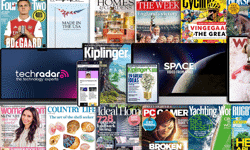They’ve been breathing a heavy sigh of relief just recently in the febrile, competitive world of women’s gossip magazines. Why? Because the Duchess of Cambridge, to use her full honorific, or “Kate” as she is known to hard-pressed and suddenly grateful editors, is working for them.
If recent experience is anything to go by, Kate Middleton’s face on the cover sells magazines, from the posh society titles through the slimming and health magazines to the supermarket weeklies. This is terrific news. Cheryl Cole was very close to running out of steam, Jennifer Aniston was looking dangerously middle-aged and Big Brother is heading so far downmarket that few of the magazines will particularly wish to follow.
What a boon it is to suddenly have this attractive young woman, who appeals to everyone from the strap-hanging commuter girls clutching a can of Red Bull to ward off a clubbing hangover through the bride-to-be planning her trousseau to the infant-encumbered housewife making her way round Tesco. And, what’s more, since she’s not a pop star or film star, Kate Middleton is constitutionally obliged to be available to have her picture taken a couple of times every week, preferably in a new outfit. In the unlikely event she’s not around, then you can rely on her sister, the slightly racier model, being available.
Neither is going to be controlled by the release schedules of any studio or TV company, nor are they going to be wrapped up in exclusive deals with Richard Desmond or Time Warner. Kate’s on tap, a national resource, and just as she has already proved to be a big shot in the arm for the British fashion industry, she may well do the same for the women’s part of the British magazine business.
Her husband’s mother was of course the perfect cover star - particularly in the later years when she was that most sought-after figure they still talk wistfully about in American magazine publishing, the holy grail, the “famous beautiful woman with a problem” – but even she didn’t touch as many bases as Kate, who’s a figure that the younger readers of Grazia and Look can identify with.
Cover stars
The relief flooding through IPC, Condé Nast, Bauer and the rest only underlines just how few famous faces can carry a cover. The man in the street probably thinks editors of personality magazines are able to choose from an endless parade of reality TV stars, minor members of the aristocracy and the burgeoning legions of actresses / models / whatevers. In reality, it doesn’t work as easily as that. Personalities are being thrown up all the time. Stars, on the other hand, can’t simply be whistled up.
Editors in every field know how cruelly narrow their repertoire actually is. When you live and die by the 15% variance in sales, you quickly learn that in the unforgiving world of covers, a miss can be as good as a mile. It’s become a commonplace to observe that celebrity culture is turning out an enormous number of new faces who achieve enough fame to get quite a bit of play on the Daily Mail website, be the subject of some gossip on TMZ or fill a sofa on breakfast TV but that doesn’t increase the number of people who will “work” on a magazine cover.
There’s something about paper that resists the ephemeral. For every Amy Winehouse, who sells, there are a million Adeles and Duffys who don’t. For every Jennifer Aniston, who in her day captured the public imagination, there are legions of Gwyneth Paltrows and Emma Watsons who don’t. There is no way of telling the difference. It doesn’t make any sense and there’s no way of testing the popularity of a person or idea other than in the cruel world of the newsagents’ shelves.
Formulaic approach
It’s not just in the world of celebrities. Each specialist area of the magazine business has its own highly developed rules of what works on a cover and what doesn’t: car magazines sell best with a red sports car on the cover, generally presented at a slight angle as if it’s running you over; angling magazines have to have a freshly landed record-breaking catch displayed on its side; slimming magazines should promise a diet which will enable you to lose a specific amount in a limited period of time; movie magazines offer exclusive on-set photographs from films with lots of special effects; men’s fitness magazine covers are generally black and white pictures of men with washboard abs taken on the beach in Florida; Country Life always features an English country garden, music magazines alternate between the Beatles or Oasis, the Radio Times doesn’t go for long without featuring Dr Who or Michael Palin, GQ features a leggy, expensive woman from overseas and Take A Break usually finds room for the word “hell”. A period homes magazines usually has a fire in the fireplace, a mainstream homes title will have a room ready to host a dinner party in, travel magazines are overwhelmingly blue, Cosmopolitan has cleavage, Vogue has hauteur, people on the cover of Good Housekeeping always smile, Vanity Fair cover stars always look obscenely rich, football magazines feature either Manchester United or Arsenal and technology magazines have a girl wearing a bikini who’s wondering what is this gadget she’s holding in her right hand. It’s easy to laugh at these clichés but every one of these rules has been arrived at via a bitter process of trial and error.
Age of conservatism
The problem is these covers become not merely an attractive wrapper for the contents inside but also a predictor of said contents. There’s precious little room for originality or surprise when you’ve learned the formula so well and you’re under pressure from the competition.
That’s the problem with what’s happening at present. People under pressure either innovate or retrench. At the moment, it’s mainly the latter. Magazines only really develop new ways of doing things when they’re reaching out and appealing to completely new audiences, or at least tiptoeing into new areas. This doesn’t seem to be happening at the moment. There’s an air of what we have we hold which is not going to result in the kind of exciting approach which is likely to catalyse a new audience.
And make no mistake. Magazines have to find new audiences if they’re to grow. It’s no use thinking they can drift along with their heritage users and carve out enough of a future there. In fact, what’s happening at the moment is that as magazines retreat to their core, they’re finding their readers are even pickier and less forgiving than they were in the past. As a consequence, the titles - and their covers - look more and more conservative.
A golden age?
No wonder art directors look back with nostalgia to an age they never knew, when Esquire brought in Madison Avenue man George Lois to design a load of covers which defined high concept: Muhammad Ali as St Sebastian, Virna Lisi shaving, Andy Warhol being sucked into a giant Campbell’s soup can. You don’t even have to go as far back as that to find more innovation than we’ve got today. Look at Pearce Marchbank’s Bootleg cover or his Elvis mask covers of Time Out from the 80s. Even the cover of Smash Hits I was involved with, which had Stray Cats on one cover, Kim Wilde on the other, reading one way from the back and another way from the front. Only Wired seem to exhibit this kind of imagination and dash today.
Compared to some of the above, the 2010 winners of the industry cover awards, The Maggies, seem to reward work which is polished and professional rather than imaginative and likely to grab the attention of the wider world. They’re all well enough executed, but you can’t imagine them being discussed over the dinner table like the pregnant Demi Moore on the cover of Vanity Fair. And that’s the challenge - to be discussed in the real world, not simply admired in a competition or on a coffee table. What magazines as a medium need to do is recapture the imagination of sections of the public who think they can get by without them.
Breakthrough needed
Our cultural problem is that for years, magazine professionals have prided themselves on the fact that they don’t need telling what the customer wants. It could be that keeping up that pretence is preventing us doing the radical things that need doing. I feel at the moment, we’re waiting for a breakthrough. When was the last time a magazine cover was really talked about? It could be that we’re all running so scared of retailers and interest groups that it’s the last thing we want.
In some ways, the most shocking thing you can do is just turn the matter over to the public and allow them to choose. That’s what the venerable music and lifestyle magazine Rolling Stone has done in the United States, probably in desperation. Rather than rotate their usual list of cover stars, they’ve launched a national competition for an up and coming act to be on the cover of the magazine. It’s very easy to sniff at this kind of thing and insist that the magazine shouldn’t be sprinkling around its kudos so lightly and what has it come to when what started out as an “alternative paper” is suddenly copying Simon Cowell’s ideas. Nobody will be sniggering if it turns out to work, which, by getting the attention of tiny communities of fans all over the States and getting talked about at some dinner tables at least, it probably has done already.
ShortList, the men’s title which is given away free, has adverts, often quite striking ones, on the front cover. That’s probably the kind of thing that’s OK on the cover of something you’re handed when walking out of a tube station. But not so fast. I can remember the days when the NME had adverts all over its front page. There is nothing about today’s basic magazine template that is guaranteed to be here in ten years time. In the worlds of television and newspapers, they’re already doing things that they would have considered inconceivable ten years ago. At the same time, magazines have continued pretty much down the same path they’ve trodden over the last twenty. They’ve become more polished and professional. They haven’t become a whole lot better. They’re satisfying a lot of their core constituencies, but unless they can leap out and excite some new people, the future is going to be about diminishing returns. It will take more than a glamorous new royal to do that.










